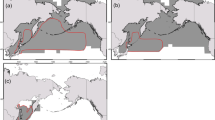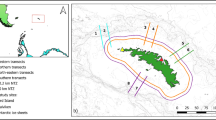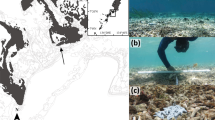Abstract
Studying the trophic ecology of marine fishes in their natural habitat provides insights into their behavior, their role in community dynamics, and in energy flow through ecosystems. The long tail hake Macruronus magellanicus Lönnberg, 1907, is distributed from 35°S in the Atlantic Ocean and 33°S in the Pacific Ocean and supports important fisheries around the southern tip of South America. The trophic ecology of this species was evaluated in the Southwestern Atlantic (52°–56°S, 106 to 932 m depth) for the first time. This is the main fishing area in the southern region of its distribution. Stomach contents and C and N stable isotope analysis were used to assess ontogenetic and spatial variability in long tail hake diet. The main prey items identified in the stomach contents varied spatially, differentiating three feeding grounds with euphausiids, Fuegian sprats (Sprattus fuegensis), and squat lobsters (Munida gregaria) as the main prey in each. However, these differences were not reflected in the stable isotope signals of their muscles. Our results suggest that long tail hake move between feeding grounds in a shorter time period than the isotopic turnover rate of muscle (~ 2–5 months). Independent of the feeding grounds, both methodologies showed ontogenetic variability in diet. Our evidence suggests in the southern tip of South America, long tail hake move among grounds to take advantage of the availability of different resources. These results provide valuable information on the trophic ecology of long tail hake to consider in management and conservation policies.





Similar content being viewed by others
Data availability
The datasets generated during and/or analyzed during the current study are available from the corresponding author on reasonable request.
Code availability
Not applicable.
References
Acevedo J, Urbán J (2021) Estimates of Fuegian sprat consumption by humpback whales in the Magellan Strait feeding area as predicted by a bioenergetic model. Mar Ecol Prog Ser 657:223–239. https://doi.org/10.3354/meps13543
Alemany D, Iribarne O, Acha E (2018) Marine fronts as preferred habitats for young Patagonian hoki Macruronus magellanicus on the southern Patagonian shelf. Mar Ecol Prog Ser 588:191–200. https://doi.org/10.3354/meps12454
Baker R, Buckland A, Sheaves M (2014) Fish gut content analysis: robust measures of diet composition. Fish Fish 15:170–177. https://doi.org/10.1111/faf.12026
Belleggia M, Figueroa DE, Irusta G, Bremec C (2014) Spatio-temporal and ontogenetic changes in the diet of the Argentine hake Merluccius hubbsi. J Mar Biol Assoc UK 94:1701–1710. https://doi.org/10.1017/s0025315414000629
Belleggia M, Giberto D, Bremec C (2017) Adaptation of diet in a changed environment: increased consumption of lobster krill Munida gregaria (Fabricius, 1793) by Argentine hake. Mar Ecol 38:e12445. https://doi.org/10.1111/maec.12445
Bestley S, Patterson TA, Hindell MA, Gunn JS (2010) Predicting feeding success in a migratory predator: integrating telemetry, environment, and modeling techniques. Ecology 91:2373–2384. https://doi.org/10.1890/08-2019.1
Boecklen WJ, Yarnes CT, Cook BA, James AC (2011) On the use of stable isotopes in trophic ecology. Annu Rev Ecol Evol Syst 42:411–440. https://doi.org/10.1146/annurev-ecolsys-102209-144726
Brickle P, Arkhipkin AI, Laptikhovsky V, Stocks A, Taylor A (2009) Resource partitioning by two large planktivorous fishes Micromesistius australis and Macruronus magellanicus in the Southwest Atlantic. Estuar Coast Shelf Sci 84:91–98. https://doi.org/10.1016/j.ecss.2009.06.007
Briggs JC (1974) Marine zoogeography. McGraw-Hill, New York
Briggs JC, Bowen BW (2012) A realignment of marine biogeographic provinces with particular reference to fish distributions: marine biogeographic provinces. J Biogeogr 39:12–30. https://doi.org/10.1111/j.1365-2699.2011.02613.x
Buckland A, Baker R, Loneragan N, Sheaves M (2017) Standardising fish stomach content analysis: the importance of prey condition. Fish Res 196:126–140. https://doi.org/10.1016/j.fishres.2017.08.003
Burnham KP, Anderson DR, Burnham KP (2002) Model selection and multimodel inference: a practical information-theoretic approach, 2nd edn. Springer, New York
Casarsa L, Diez MJ, Madirolas A, Cabreira AG, Buratti CC (2019) Morphometric description of schools from two different stocks of the southernmost sprat Sprattus fuegensis. Fish Res 212:29–34. https://doi.org/10.1016/j.fishres.2018.12.004
Cepeda GD, Temperoni B, Sabatini ME, Viñas MD, Derisio CM, Santos BA, Antacli JC, Padovani LN (2018) Zooplankton communities of the Argentine Continental Shelf (SW Atlantic, ca. 34°–55°S), an overview. In: Hoffmeyer MS, Sabatini ME, Brandini FP, Calliari DL, Santinelli NH (eds) Plankton ecology of the Southwestern Atlantic. Springer, Cham, pp 171–199
Charrad M, Ghazzali N, Boiteau V, Niknafs A (2014) NbClust: an R Package for determining the relevant number of clusters in a data set. J Stat Softw. https://doi.org/10.18637/jss.v061.i06
Ciancio JE, Pascual MA, Botto F, Frere E, Iribarne O (2008) Trophic relationships of exotic anadromous salmonids in the southern Patagonian Shelf as inferred from stable isotopes. Limnol Oceanogr 53:788–798. https://doi.org/10.4319/lo.2008.53.2.0788
Clark M (1985) The food and feeding of seven fish species from the Campbell Plateau, New Zealand. New Zeal J Mar Fresh 19:339–363. https://doi.org/10.1080/00288330.1985.9516100
Coletto JL, Botta S, Fischer LG, Newsome SD, Madureira LSP (2021) Isotope-based inferences of skipjack tuna feeding ecology and movement in the southwestern Atlantic Ocean. Mar Environ Res 165:105246. https://doi.org/10.1016/j.marenvres.2020.105246
Connell A, Dunn M, Forman J (2010) Diet and dietary variation of New Zealand hoki Macruronus novaezelandiae. N Z J Mar Freshw Res 44:289–308. https://doi.org/10.1080/00288330.2010.515232
Cortés E (1997) A critical review of methods of studying fish feeding based on analysis of stomach contents: application to elasmobranch fishes. Can J Fish Aquat Sci 54:726–738. https://doi.org/10.1139/f96-316
Cousseau MB, Pequeño G, Mabragaña E, Lucifora LO, Martínez P, Giussi A (2020) The Magellanic Province and its fish fauna (South America): several provinces or one? J Biogeogr 47:220–234. https://doi.org/10.1111/jbi.13735
Crawley MJ (2013) The R book, 2nd edn. Wiley, Chichester
Diez MJ, Rojas-Quiroga ML, Pérez-Barros P, Lezcano A, Florentín O, Lovrich GA (2016a) “Gregaria” to “subrugosa”, that is the question: shape changes under laboratory conditions in the pelagic morphotype of the squat lobster Munida gregaria (Fabricius, 1793) (Decapoda: Anomura: Munididae). J Crustac Biol 36:530–537. https://doi.org/10.1163/1937240X-00002442
Diez MJ, Cabreira AG, Madirolas A, Lovrich GA (2016b) Hydroacoustical evidence of the expansion of pelagic swarms of Munida gregaria (Decapoda, Munididae) in the Beagle Channel and the Argentine Patagonian Shelf, and its relationship with habitat features. J Sea Res 114:1–12. https://doi.org/10.1016/j.seares.2016.04.004
Elliott KH, Roth JD, Crook K (2017) Lipid extraction techniques for stable isotope analysis and ecological assays. In: Bhattacharya SK (ed) Lipidomics. Springer, New York, pp 9–24
Giussi AR, Zavatteri A, Di Marco E, Gorini FL, Bernardele JC, Marí NR (2016) Biology and fishery of long tail hake (Macruronus magellanicus) in the Southwest Atlantic Ocean. Rev Investig Desarro Pesq 28:55–82
Gorini F, Lukaszewicz G, Giussi AR (2021a) Actualización de la estadística pesquera de peces demersales australes en el Atlántico Sudoccidental (Período 2008–2020). INIDEP Inf Tec 27:1–64
Gorini F, Zumpano F, Ruocco N, Giussi A, Avigliano E (2021b) Spatial population structure of long tail hake from Southwest Atlantic and Southeast Pacific waters in young and adult stages. Estuar Coast Shelf Sci 257:107419. https://doi.org/10.1016/j.ecss.2021.107419
Graham BS, Koch PL, Newsome SD, McMahon KW, Aurioles D (2010) Using isoscapes to trace the movements and foraging behavior of top predators in oceanic ecosystems. In: West JB, Bowen GJ, Dawson TE, Tu KP (eds) Isoscapes. Springer, Netherlands, pp 299–318
Griffiths HJ, Barnes DKA, Linse K (2009) Towards a generalized biogeography of the Southern Ocean benthos. J Biogeogr 36:162–177. https://doi.org/10.1111/j.1365-2699.2008.01979.x
Guihou K, Piola AR, Palma ED, Chidichimo MP (2020) Dynamical connections between large marine ecosystems of austral South America based on numerical simulations. Ocean Sci 16:271–290. https://doi.org/10.5194/os-16-271-2020
Hayden B, Palomares MLD, Smith BE, Poelen JH (2019) Biological and environmental drivers of trophic ecology in marine fishes—a global perspective. Sci Rep 9:11415. https://doi.org/10.1038/s41598019-47618-2
Hoffman JC, Sutton TT (2010) Lipid correction for carbon stable isotope analysis of deep-sea fishes. Deep Sea Res Pt I 57:956–964. https://doi.org/10.1016/j.dsr.2010.05.003
Ishikawa NF, Ogawa NO, Chikaraishi Y, Yamaguchi M, Fujikura K, Miyairi Y, Yokoyama Y, Nagata T, Ohkouchi N (2021) Influences of ocean currents on the diets of demersal fish communities in the Western North Pacific revealed by their muscle carbon and nitrogen isotopic compositions. Front Mar Sci 8:641282. https://doi.org/10.3389/fmars.2021.641282
Jackson AL, Inger R, Parnell AC, Bearhop S (2011) Comparing isotopic niche widths among and within communities: SIBER—stable isotope bayesian ellipses in R: Bayesian isotopic niche metrics. J Anim Ecol 80:595–602. https://doi.org/10.1111/j.1365-2656.2011.01806.x
Karl H, Lehmann I, Manthey-Karl M et al (2014) Comparison of nutritional value and microbiological status of new imported fish species on the German market. Int J Food Sci Technol 49:2481–2490. https://doi.org/10.1111/ijfs.12543
Kiljunen M, Grey J, Sinisalo T et al (2006) A revised model for lipid-normalizing δ13C values from aquatic organisms, with implications for isotope mixing models: revised lipid-normalization model for C isotope analysis. J Appl Ecol 43:1213–1222. https://doi.org/10.1111/j.1365-2664.2006.01224.x
Kuo C, Tanaka S (1984) Feeding habit of hoki Macruronus novaezelandiae (Hector) in waters around New Zealand. B Jpn Soc Sci Fish 50:783–786. https://doi.org/10.2331/suisan.50.783
Levingston ME, Rosemary JH, O’Driscoll RL, McKenzie A, Ballara SL, Horn PL (2015) Biology and fisheries of New Zealand hoki (Macruronus novaezelandiae). In: Arancibia H (ed) Hakes biology and exploitation. Wiley, London, pp 127–153
Logan JM, Lutcavage ME (2008) A comparison of carbon and nitrogen stable isotope ratios of fish tissues following lipid extractions with non-polar and traditional chloroform/methanol solvent systems. Rapid Commun Mass Sp 22:1081–1086. https://doi.org/10.1002/rcm.3471
Logan JM, Jardine TD, Miller TJ et al (2008) Lipid corrections in carbon and nitrogen stable isotope analyses: comparison of chemical extraction and modelling methods. J Anim Ecol 77:838–846. https://doi.org/10.1111/j.1365-2656.2008.01394.x
Madigan D, Brooks E, Bond M, Gelsleichter J, Howey L, Abercrombie D, Brooks A, Chapman D (2015) Diet shift and site-fidelity of oceanic whitetip sharks Carcharhinus longimanus along the Great Bahama Bank. Mar Ecol Prog Ser 529:185–197. https://doi.org/10.3354/meps11302
Marí NR, Giussi AR (2016) Agrupamiento de especies en las operaciones de pesca realizadas en la pesquería de merluza de cola. INIDEP Inf Invest 45:1–13
McMahon KW, Hamady LL, Thorrold SR (2013) A review of ecogeochemistry approaches to estimating movements of marine animals. Limnol Oceanogr 58:697–714. https://doi.org/10.4319/lo.2013.58.2.0697
Ménard F, Lorrain A, Potier M, Marsac F (2007) Isotopic evidence of distinct feeding ecologies and movement patterns in two migratory predators (yellowfin tuna and swordfish) of the Western Indian Ocean. Mar Biol 153:141–152. https://doi.org/10.1007/s00227-007-0789-7
Muggeo VM (2008) Segmented: an R package to fit regression models with broken-line relationships. R News 8(1):20–25
Newsome SD, del Rio CM, Bearhop S, Phillips DL (2007) A niche for isotopic ecology. Front Ecol Environ 5:429–436
Oksanen J, Blanchet GF, Friendly M, Kindt R, Legendre P, McGlinn D, Minchin PR et al. (2019) Vegan: community ecology package. R package version 2.5–6
Padovani LN, Viñas MD, Sánchez F, Mianzan H (2012) Amphipod-supported food web: Themisto gaudichaudii, a key food resource for fishes in the southern Patagonian shelf. J Sea Res 67:85–90. https://doi.org/10.1016/j.seares.2011.10.007
Peterson BJ, Fry B (1987) Stable isotopes in ecosystem studies. Annu Rev Ecol Syst 18:293–320. https://doi.org/10.1146/annurev.es.18.110187.001453
Petta JC, Shipley ON, Wintner SP, Cliff G, Dicken ML, Hussey NE (2020) Are you really what you eat? Stomach content analysis and stable isotope ratios do not uniformly estimate dietary niche characteristics in three marine predators. Oecologia 192:1111–1126. https://doi.org/10.1007/s00442-020-04628-6
Pimm SL (2002) Food webs. University of Chicago Press, Chicago, p 219
Piola AR, Palma ED, Bianchi AA, Castro BM, Dottori M, Guerrero RA, Marrari M, Matano RP, Möller OO, Saraceno M (2018) Physical oceanography of the SW Atlantic shelf: a review. In: Hoffmeyer MS, Sabatini ME, Brandini FP, Calliari DL, Santinelli NH (eds) Plankton ecology of the Southwestern Atlantic. Springer, Cham, pp 37–56
Piola AR, Rivas AL (1997) Corrientes en la Plataforma Continental. In: Boschi EE (ed) El Mar Argentino y sus recursos pesqueros. Tomo I. INIDEP, Mar del Plata, pp 119−132
Post DM (2002) Using stable isotopes to estimate trophic position: models, methods, and assumptions. Ecology 83:703–718. https://doi.org/10.1890/0012-9658(2002)083[0703:USITET]2.0.CO;2
Post DM, Layman CA, Arrington DA, Takimoto G, Quattrochi J, Montaña CG (2007) Getting to the fat of the matter: models, methods and assumptions for dealing with lipids in stable isotope analyses. Oecologia 152:179–189. https://doi.org/10.1007/s00442-006-0630-x
Prenski LB, Morales-Yokobori ML, Minte VC, Bridi J, Landa P, Di Giacomo E, Perier M (2012) Public Certification Report. Assessment against MSC Principles and Criteria for Argentine Hoki (Macruronus magellanicus) bottom and semi pelagic trawl net fishery. Organización Internacional Agropecuaria. pp 822
Riccialdelli L, Becker Y, Fioramonti N, Torres M, Bruno D, Raya Rey A, Fernández D (2020) Trophic structure of southern marine ecosystems: a comparative isotopic analysis from the Beagle Channel to the oceanic Burdwood Bank area under a wasp-waist assumption. Mar Ecol Prog Ser 655:1–27. https://doi.org/10.3354/meps13524
Rivas AL, Pisoni JP (2010) Identification, characteristics and seasonal evolution of surface thermal fronts in the Argentinean Continental Shelf. J Mar Syst 79:134–143. https://doi.org/10.1016/j.jmarsys.2009.07.008
Rivas AL, Dogliotti AI, Gagliardini DA (2006) Seasonal variability in satellite-measured surface chlorophyll in the Patagonian Shelf. Cont Shelf Res 26:703–720. https://doi.org/10.1016/j.csr.2006.01.013
Sabadin DE, Lucifora LO, Barbini SA, Figueroa DE, Kittlein M (2020) Towards regionalization of the chondrichthyan fauna of the Southwest Atlantic: a spatial framework for conservation planning. ICES J Mar Sci 77:1893–1905. https://doi.org/10.1093/icesjms/fsaa064
Sabatini M, Reta R, Matano R (2004) Circulation and zooplankton biomass distribution over the southern Patagonian shelf during late summer. Cont Shelf Res 24:1359–1373. https://doi.org/10.1016/j.csr.2004.03.014
Sabatini ME, Akselman R, Reta R, Negri RM, Lutz VA, Silva RI, Segura V, Gil MN, Santinelli NH, Sastre AV, Daponte MC, Antacli JC (2012) Spring plankton communities in the southern Patagonian shelf: hydrography, mesozooplankton patterns and trophic relationships. J Mar Syst 94:33–51. https://doi.org/10.1016/j.jmarsys.2011.10.007
Sabatini ME, Reta R, Lutz VA, Segura V, Daponte C (2016) Influence of oceanographic features on the spatial and seasonal patterns of mesozooplankton in the Southern Patagonian shelf (Argentina, SW Atlantic). J Mar Syst 157:20–38. https://doi.org/10.1016/j.jmarsys.2015.12.006
Sánchez RP, Remeslo A, Madirolas A, de Ciechomski JD (1995) Distribution and abundance of post-larvae and juveniles of the Patagonian sprat, Sprattus fuegensis, and related hydrographic conditions. Fish Res 23:47–81. https://doi.org/10.1016/0165-7836(94)00339-X
Sánchez-Hernández J, Nunn AD, Adams CE, Amundsen P-A (2019) Causes and consequences of ontogenetic dietary shifts: a global synthesis using fish models: ontogenetic dietary shifts. Biol Rev 94:539–554. https://doi.org/10.1111/brv.12468
Schejter L, Rimondino C, Chiesa I, Díaz de Astarloa JM, Doti B, Elías R, Escolar M, Genzano G, López-Gappa J, Tatián M, Zelaya DG, Cristobo J, Perez CD, Cordeiro RT, Bremec CS (2016) Namuncurá marine protected area: an oceanic hot spot of benthic biodiversity at Burdwood Bank, Argentina. Polar Biol 39:2373–2386. https://doi.org/10.1007/s00300-016-1913-2
Schuchert PC, Arkhipkin AI, Koenig AE (2010) Traveling around Cape Horn: otolith chemistry reveals a mixed stock of Patagonian hoki with separate Atlantic and Pacific spawning grounds. Fish Res 102:80–86. https://doi.org/10.1016/j.fishres.2009.10.012
Secor DH (2015) Migration ecology of marine fishes. Johns Hopkins University Press, Baltimore
Sherman K, Duda AM (1999) Large marine ecosystems: an emerging paradigm for fishery sustainability. Fish Manag 24:12. https://doi.org/10.1577/15488446(1999)024%3c0015:LME%3e2.0.CO;2
Sokal RR, Rohlf FJ (1962) The comparison of dendrograms by objective methods. Taxon 11:33–40. https://doi.org/10.2307/1217208
Strub PT, James C, Montecino V, Rutllant JA, Blanco JL (2019) Ocean circulation along the southern Chile transition region (38°–46°S): Mean, seasonal and interannual variability, with a focus on 2014–2016. Prog Oceanogr 172:159–198. https://doi.org/10.1016/j.pocean.2019.01.004
Subsecretaria de Pesca y Acuicultura (2021). https://www.argentina.gob.ar/agricultura/agricultura-ganaderia-y-pesca/subsecretaria-de-pesca-y-acuicultura. Accessed 31 May 2022
Sweeting CJ, Polunin NVC, Jennings S (2006) Effects of chemical lipid extraction and arithmetic lipid correction on stable isotope ratios of fish tissues. Rapid Commun Mass Spectrom 20:595–601. https://doi.org/10.1002/rcm.2347
Tam JC, Link JS, Rossberg AG, Rogers SI, Levin PS, Rochet M-J, Bundy A, Belgrano A, Libralato S, Tomczak M, van de Wolfshaar K, Pranovi F, Gorokhova E, Large SI, Niquil N, Greenstreet SPR, Druon J-N, Lesutiene J, Johansen M, Preciado I, Patricio J, Palialexis A, Tett P, Johansen GO, Houle J, Rindorf A (2017) Towards ecosystem-based management: identifying operational food-web indicators for marine ecosystems. ICES J Mar Sci 74:2040–2052. https://doi.org/10.1093/icesjms/fsw230
Thomas SM, Crowther TW (2015) Predicting rates of isotopic turnover across the animal kingdom: a synthesis of existing data. J Anim Ecol 84:861–870. https://doi.org/10.1111/1365-2656.12326
Troccoli GH, Aguilar E, Martínez PA, Belleggia M (2020) The diet of the patagonian toothfish Dissostichus eleginoides, a deep-sea top predator off Southwest Atlantic Ocean. Polar Biol 43:1595–1604. https://doi.org/10.1007/s00300-020-02730-2
Trueman CN, St John Glew K (2019) Isotopic tracking of marine animal movement. Tracking animal migration with stable isotopes. Elsevier, Hoboken, pp 137–172
Vander Zanden MJ, Clayton MK, Moody EK, Solomon CT, Weidel BC (2015) Stable isotope turnover and half-life in animal tissues: a literature synthesis. PLoS ONE 10:e0116182. https://doi.org/10.1371/journal.pone.0116182
Vinson MR, Budy P (2011) Sources of variability and comparability between salmonid stomach contents and isotopic analyses: study design lessons and recommendations. Can J Fish Aquat Sci 68:137–151. https://doi.org/10.1139/F10-117
Acknowledgements
We acknowledge personnel of the on board observers Program of the Instituto Nacional de Investigación y Desarrollo Pesquero for sample collection particularly to L. Maydana, E. Aguilar, and F. Vázquez. O. Iribarne and M. Acha made valuable comments on first draft of the MS. We especially thank J. H. Rojo for map figs, C. M. Díaz de Astarloa for language review, and L. I. Bruno for his help in processing the samples. We also acknowledge valuable suggestions from anonymous reviewers. This study was partially supported by Servicios Técnologicos de Alto Nivel, Consejo Nacional de Investigaciones Científicas y Técnicas (Argentina) to F. Botto, and by Estremar SA, San Arawa SA and Pesantar SA. This study is part of the Doctoral Thesis of C. D. Alvarez.
Funding
No funding was received specifically for conducting this study.
Author information
Authors and Affiliations
Contributions
All authors designed the study, processed and analyzed the data, discussed the results, and wrote the manuscript.
Corresponding author
Ethics declarations
Conflict of interest
We declare that there are no conflicts of interest for any parties involved in the development of this manuscript.
Ethical approval
This article does not contain any studies with human participants performed by any of the authors. All applicable international, national and/or institutional guidelines for the care and use of animals were followed.
Consent to participate
Not applicable.
Consent for publication
Not applicable.
Additional information
Publisher's Note
Springer Nature remains neutral with regard to jurisdictional claims in published maps and institutional affiliations.
Supplementary Information
Below is the link to the electronic supplementary material.
Rights and permissions
About this article
Cite this article
Alvarez, C.D., Giussi, A.R. & Botto, F. Trophic variability of long tail hake Macruronus magellanicus in the Southwestern Atlantic: movements evidenced by stomach content and stable isotope analysis. Polar Biol 45, 1131–1143 (2022). https://doi.org/10.1007/s00300-022-03063-y
Received:
Revised:
Accepted:
Published:
Issue Date:
DOI: https://doi.org/10.1007/s00300-022-03063-y





